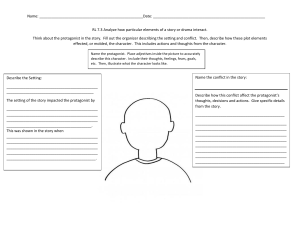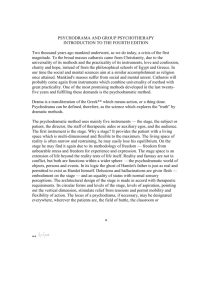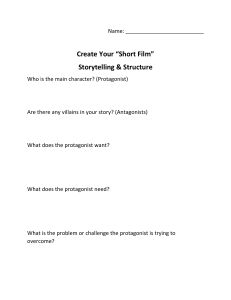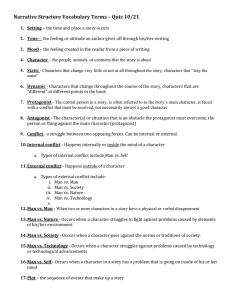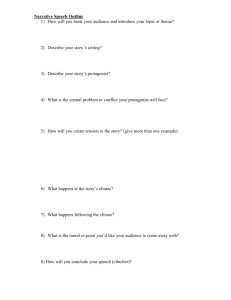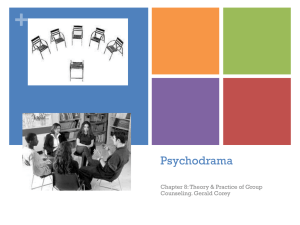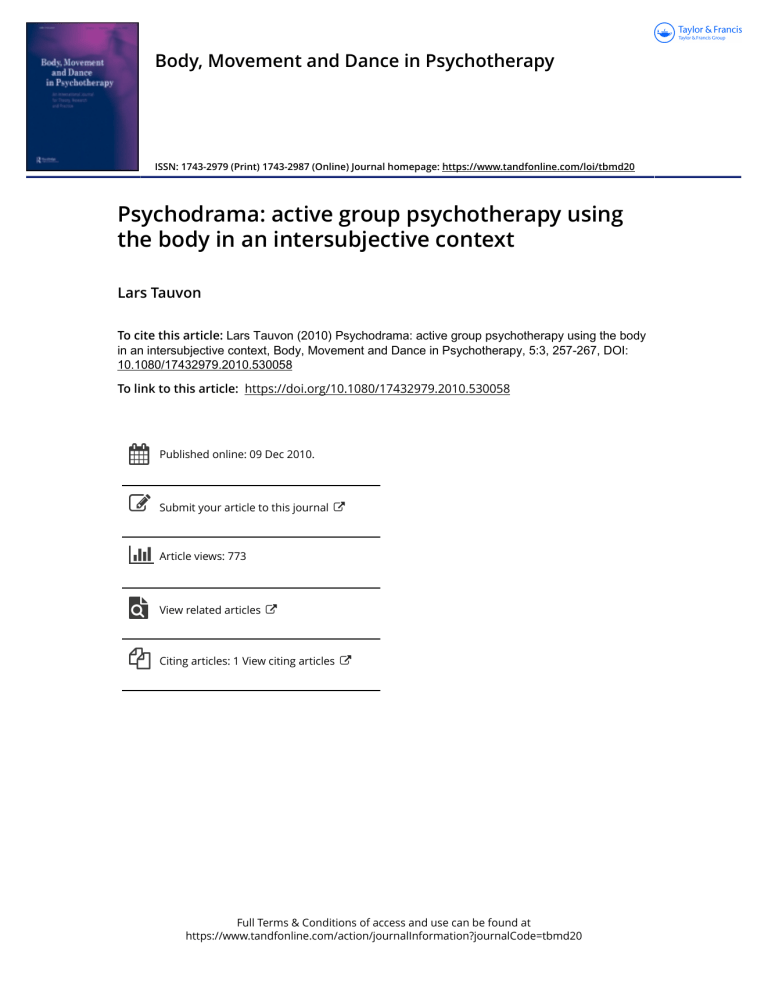
Body, Movement and Dance in Psychotherapy ISSN: 1743-2979 (Print) 1743-2987 (Online) Journal homepage: https://www.tandfonline.com/loi/tbmd20 Psychodrama: active group psychotherapy using the body in an intersubjective context Lars Tauvon To cite this article: Lars Tauvon (2010) Psychodrama: active group psychotherapy using the body in an intersubjective context, Body, Movement and Dance in Psychotherapy, 5:3, 257-267, DOI: 10.1080/17432979.2010.530058 To link to this article: https://doi.org/10.1080/17432979.2010.530058 Published online: 09 Dec 2010. Submit your article to this journal Article views: 773 View related articles Citing articles: 1 View citing articles Full Terms & Conditions of access and use can be found at https://www.tandfonline.com/action/journalInformation?journalCode=tbmd20 Body, Movement and Dance in Psychotherapy Vol. 5, No. 3, December 2010, 257–267 Psychodrama: active group psychotherapy using the body in an intersubjective context Lars Tauvon* Skånegatan 87, 2 tr., SE116 35 Stockholm, Sweden (Final version received 5 October 2010) Psychodrama is an active form of group psychotherapy. It involves the body as the main container of the constituents for therapeutic action, i.e. emotions and implicit memories. Psychodrama is an early intersubjective approach aiming at a genuine encounter in the here-and-now, necessary for a therapeutic change. The article describes how the body gets involved during the different phases of the psychodrama. What happens on the psychodramatic stage is described as interaction of roles. This article also gives an overview of psychodramatic role theory, as it was formulated by its founder J.L. Moreno and developed by his followers. Its usefulness in clinical work is presented. Keywords: psychodrama; role theory; body psychotherapy; intersubjectivity; implicit factors Introduction Psychodrama uses action methods in the form of spontaneous drama to illustrate human processes. The action involves the body and all the senses directly. The spontaneous expression of implicit knowledge and the facilitation of emotions add to the richness of experience and understanding. Psychodrama and body therapy are overlapping fields of knowledge mutually helpful in the therapeutic work. The aim of the article is to share knowledge about psychodrama with my body therapist colleagues, stimulate interdisciplinary thinking and point out how modern research can elucidate intuitively formed thinking and praxis. *Email: lars.tauvon@gmail.com ISSN 1743–2979 print/ISSN 1743–2987 online ß 2010 Taylor & Francis DOI: 10.1080/17432979.2010.530058 http://www.informaworld.com 258 L. Tauvon 1. The psychodrama session Psychodrama is mainly a form of Group Therapy using the dramatic medium. A typical session contains: . A warm up phase that helps the group members to focus on the process here and now. . Following this, an action phase where one member, the protagonist, is chosen to display his/her theme, which often is the theme of the whole group. With help of the director, the protagonist chooses a relevant scene from his life (which can also be a fantasy, a dream, a future projection or just anything). He also chooses other group members to perform important roles (auxiliaries) in the drama. The basic technique of role reversal is used to let the protagonist show his inner pictures of the important ‘others’, for instance: ‘Can you show us how your father behaves in this situation? What does he say?’ The drama may contain many role reversals and consist of one or several scenes. . After the action is finished, the group sits down in a circle. In this phase, the other members share with the protagonist their own feelings from watching or playing roles in the drama and what they can recognise from their own lives. This is an important phase, which is designed to integrate the protagonist back into the group, through an empathetic and emotional feedback. It is also important for the auxiliaries to be de-roled from emotionally laden roles. Very often it appears that both auxiliaries and the audience benefit therapeutically from the drama. . Clinical illustrations in the text below are drawn from my praxis with weekly continuous groups, where the members volunteer to participate for at least one year. Roles are illustrated and worked with on the psychodramatic stage. The main function of the psychodramatic techniques is to bring about genuine encounters on the stage. It offers an opportunity to analyse the displayed roles of the protagonist. An inadequate role is usually a projection into the present moment of a dysfunctional or ‘coping’ role. It is important for the protagonist to see and emotionally understand which roles are missing or inadequate. Role reversals give him the possibility to see himself through the eyes of another. Put in the role of the reflecting observer (which means watching the scene from outside while an auxiliary mirrors his own role), he can gain a spontaneous insight and enter the scene again in a more adequate role. The feedback from the group members is also helpful. This role analysis can give clues as to how to perform and develop new, difficult or initially anxiety provoking roles (Role training). Any psychodramatic performance implies a certain feature of exposure to situations and feelings that would be otherwise avoided and thus serves a desensitising purpose. These techniques Body, Movement and Dance in Psychotherapy 259 have during later years also become widely used in the practise of cognitive behaviour therapy. 2. The body in psychodrama The bodily aspects, as reflected in the protagonist’s behaviour, often give the best clues as to how to start the drama and to understand the hidden emotional parts. Feelings may be too shameful or forbidden or may be repressed and only displayed in implicit communication. People express with tense shoulders, dogged chins, inhibited breathing or clenched fists what words fail to reveal. It is part of the basic knowledge of body psychotherapy, as pointed out early on by Reich (1980), that memories and their related feelings seem to be ‘stored’ in the body as unconscious habitual muscle tension (‘armouring’), movement patterns and vegetative symptoms and can be released and their meaning brought to consciousness through body awareness, touch or movements. Also in psychodrama, we can use the same clues and transform the physical signs and symptoms into psychodramatic roles through concretisation. That is a way to structure and make explicit the implicit knowledge signified by the physical signs. The protagonist is asked to play his clenched fist, his headache, his sexual organ or whatever seems obvious to focus on: Director: ‘John, reverse roles with your headache! As headache show how you treat John and tell him why you do it’. Protagonist in the role as ‘headache’: (takes a firm grip at the top of the skull of the auxiliary who now is in the role of the protagonist) ‘I’ll give you a real pain – I’ll press hard – you will have no chance to avoid me. You really deserve this, you dirty bastard’. The drama may go on and the headache may be revealed as the boss, the father or any other internalised authority figure. Such dialogues may lead to new scenes. The protagonist may go back in time to the moment when this particular symptom (role) first appeared. This may happen spontaneously or through guidance from the director: Director: ‘Do you recall the first time in your life when you experienced this headache?’ Protagonist: ‘Yes, I was seven years old. I lay alone in bed. I heard my parents having an argument in the kitchen. My father raised his voice, my mother screamed: ‘‘No, no’’ I knew he beat her up. I love my mother and I hate my father, I wanted to get up and defend her but could not. My head was heavy as a stone and the pain made me cry’. This vignette also illustrates how the psychodrama stage gives freedom to the protagonist to move in time and space and between reality and fantasy. He can also move between verbal psychodramatic dialogue and focus on body awareness. A dialogue can put words to a conflict disguised as a physical 260 L. Tauvon symptom. A focus on the body experience can deepen the exploration of the emotions of the encounter. In an emotionally laden encounter, I prefer to slow down the protagonist, asking him or her to be aware of his or her body and feelings and allow free breathing. Many different things may be important in this very moment, eye contact, touch or a hug in the context of this specific encounter. 2.1. The body in the warm up phase As mentioned above, a psychodrama session normally contains three phases: the warm up, the enactment and the sharing. Bodily factors are more or less involved in all three. The ‘Warm up’ normally involves the whole group and is the process that initiates readiness for spontaneous action in the group ultimately to find the protagonist of this session. It implies focusing on feelings, thoughts and what else is going on here-and-now to assess what is urgent to work with. It may start as a verbal exchange but often involves and is enhanced by different kinds of body action. The director can ask group members to position themselves in the room according to different criteria. They can form a map indicating where they were born or where they live. They may form subgroups in different corners according to their opinion or wishes at the moment on any topic. They can get involved in games, dances or body exercises. The bodies can also be used to form ‘spectrograms’: Dir: ‘Form a row – stand at one end if you feel absolutely comfortable here just now, at the opposite end if you would really rather prefer to leave the room’. The use of the body makes obvious feelings and preferences, which can be hard to express explicitly. Body sculpting can be used for the same purpose. Moreno (1977) used to just walk around the stage with the protagonist during the interview inviting the protagonist to a soliloquy designed to prepare for continued action. Whatever method is used most people experience that body action in itself produces a flow of thoughts. In psychodrama these may constitute clues to the continuation of the session. 2.2. The body in the action phase In the dramatic enactment the body is heavily involved. Every role has a distinct bodily factor (besides the emotional and cognitive ones) and involves body postures or movements, facial expressions and often a specific tone of voice. The director can use these clues to deepen the drama. Director: ‘Be aware of how you use your right hand and arm. – Do it again and exaggerate the movement. – Repeat and use any sound or words that comes to you’. Protagonist: (shouts at the auxiliary playing her husband) ‘Don’t come closer! Go away, go away!’ This technique of exaggerating is called maximising and is similar to body therapy praxis. In addition other feelings whose content remains implicit can be Body, Movement and Dance in Psychotherapy 261 focused upon: Director: ‘Be aware of what your arms and hands are doing – Don’t change it – just be aware of your feelings right now’. Protagonist: ‘I hug myself – I feel so lonely – I wish there were someone who really loved me’. A protagonist’s psychological conflict can be modelled by two auxiliaries trying to pull him in each direction, silently or with accompanying arguments. An external conflict (for example in a family) can be illustrated in a similar physical way. Body sculpting can be used to illustrate feelings. Family sculptures, a technique initiated long ago by Virginia Satir (Satir, Banmen, Gerber, & Gomori, 1991), can be used in many ways. After having finished the sculpture, the protagonist may reverse role with the different parts of it, express his feelings in the different positions or encounter the other parts. He may also choose to change the sculpture until it fit his needs. The director should listen to spontaneous expressions of the protagonist that can be clues to bodily deepening of the drama. They occur regularly, expressing metaphors for movements, positions or body sensations: A protagonist stages a very painful childhood situation where he felt humiliated and exclaims spontaneously: ‘I wish I for once could have parents who could support me’. The director asks two auxiliaries to play the roles of parents giving physical support, which gives the protagonist courage to handle the situation in a more assertive way. Another protagonist (a young girl) chooses to stage a scene where she is disappointed with her best friend who spoils a nice evening with complaints. The action is rather dull and it is hard to understand why she has chosen to play this scene. The protagonist says she cannot reach her antagonist. The director instructs the antagonist to try to run away and the protagonist to try to catch her. She suddenly stops in the middle of action crying and exclaims: ‘I can’t. . . . I see my mother’. The drama proceeds to a scene where she is 17 years old and has just boxed her mother’s ear. An emotionally charged encounter follows where she can ask for forgiveness and let the mother admit that she deserved the box. The scene ends with a long and warm hug between mother and daughter. 3. Catharsis and insight A psychodramatic enactment ideally proceeds to a climax, a catharsis which releases the feelings that triggered the staging of the drama. A catharsis is an expression of strong feelings and can be manifested through blushing, a change in breathing, crying, shouting, hitting or laughing. Moreno described what happens within the spectator as a ‘passive catharsis’, in contrast to the ‘active catharsis’ that characterises the participant of a religious ceremony or a psychodrama. Instead of the passive catharsis most people in Western culture attain through the consumption of all kinds of readymade products (i.e. theatre, film, TV, etc., which Moreno called 262 L. Tauvon ‘cultural conserves’), he offered psychodrama as a means for the ordinary human being to play out his own drama and attain an active catharsis. Moreno argued for catharsis as a powerful way for the individual to attain equilibrium and for drama as the method of choice: . . . we often see a patient, who puts up great resistance when asked to act out his problem. It may also happen that his mind is willing and he is able to make a start on the verbal level but the body lags behind . . . In situations like these, the spontaneity associated with verbal and mental images does not have the power to carry the body along with it. Analysis does not help; action is required. The method is to warm the subject up by means of mental and physical starters . . . It is a training in summoning spontaneity. In the course of overcoming the disequilibrium between the somatic and mental processes, larger and larger portions of the organism are brought into play, pathological tensions and barriers are swept away, and a catharsis takes place (Moreno, 1987, p. 55). No doubt Moreno attributed catharsis a great importance and regarded it as a main goal in sociodrama and psychodrama. However, he used the concept in a very wide meaning to: . . . include not only release and relief of emotions, but also integration and ordering; . . . not only an intrapsychic tension-reduction, but also an interpersonal conflict-resolution; not only a medical purification, but also a religious and aesthetic experience (Kellermann, 1992, p. 83). In such a wide meaning, catharsis obviously covers also most integrative aspects of therapy. Moreno also coined the concept ‘action-insight’ to emphasise that the process of self-discovery in psychodrama is achieved in action, which also reflects the efficacy of action as an instrument for learning and recollection. Kellermann (1992) devotes this concept to a whole chapter that is well worth considering. He certifies that it is generally agreed that intellectual insight alone does not facilitate emotional or behavioural changes. ‘It may be defined as the integration of emotional, cognitive, imaginary, behavioural and interpersonal learning experiences’ (Kellermann, 1992, p. 86). Kellermann (1992) gives some examples of how action-insight may be experienced: ‘My mind became crystal clear and every detail of my self came into focus with extraordinary clarity as if doors of perception were suddenly opened’. ‘My body was open to every sensation and I knew what I was feeling’. ‘I was aware of my needs and motives and I recognized the personal consequences of my actions’ (Kellermann, 1992, p. 87). 4. Man as an actor Moreno wrote that he wanted to give the dramatic medium back to the ordinary person as a means for his own development. Man, like all organisms, is an actor (a doer) in relation to his environment. We use our well-developed cognitive functions, our thoughts and our language but even the most abstract ideas are internalisations of actions. Every act of thinking involves some kind of muscle activity. Creativity is the key to development and change and needs Body, Movement and Dance in Psychotherapy 263 spontaneous action to manifest itself. Moreno shared with his contemporary, the philosopher Martin Buber (1923), the conviction that a genuine encounter between two (or more) individuals is the basic condition for change. Recent research by Daniel Stern (2004) on intersubjectivity, performed with sophisticated experimental models and video recordings, confirm these views and stress their importance in psychotherapy, as well as in everyday life. The mirror neurons (Bauer, 2005) are necessary for this process. Situated in the brain, adjacent to the motor neurons, they have the special function implicitly to register the intentional movements of another person. They seem to be responsible for imitation and learning capacity from birth onwards and to be the substrate for empathetic resonance between individuals in the encounter. Their importance for the efficiency of psychodramatic practise cannot be overestimated. 5. Psychodramatic theory of roles In the subsequent part of the article, I shall introduce the psychodramatic theory of roles, as it was developed already in the 1920s of J.L. Moreno, the founder of psychodrama. The theory is phenomenologically based. It describes what happens on the stage in a therapy based on dramatic action. It is practical to describe what happens in a drama in role-terms. Unlike Freud, Moreno did not assume any meta-psychological structure behind his theory. Moreno coined the concept ‘tele’ to indicate the mutual emotional flow in the encounter between two individuals. This is probably the very first interpersonal theory referring to a therapeutic context, strongly diverging from the sustained emphasis on intra-psychic process upheld by Freud’s early strong influence. In body psychotherapy, from Reich onwards, the intrapsychic or intra-organismic process has also been the focus of attention, which has been reflected in the terminology and the practise. A major progress has nonetheless occurred in later years, influenced by modern research about intersubjectivity (Stern, 2004). The role is defined as the manifest expression of the ego in the encounter with another role, the counter role. Every role has an emotional, a cognitive and a behavioural aspect. Roles are coloured by both cultural and personal elements. Moreno distinguished between psychosomatic, social and psychodramatic roles. The psychosomatic are expressions of body functions, of which many have a genetic basis and are present at birth. The social roles reflect the values of the society. The psychodramatic roles develop from birth through the interaction between the baby and its surrounding care takers. A healthy baby is genetically equipped with what can be regarded as roles, fit to build up the attachment to the care giver; generally the mother, of course (Stern, 1995, 2004). 5.1. Psychosomatic roles The psychosomatic roles are for instance the roles of the sleeper, the eater, the breather, the lover. They dominate the interaction in early life, but have 264 L. Tauvon tremendous importance as expressions of basic lifelong functions. Wellfunctioning psychosomatic roles are important for health and well-being. As can be easily understood, they play an important role in psychological suffering as in disturbances of eating, sleeping, sexuality, pain and of course psychosomatic diseases. If body awareness is badly developed or repressed, which is a major concern in body psychotherapy, psychosomatic roles are split off from the personality and seen as strange, threatening and painful symptoms. 5.2. Social roles The social roles are defined by properties assigned by the culture to professions, social positions and family. A culture’s social roles are intimately connected with the most profound moral values of the society, with political opinions, with the structure of their institutions, organisations and with the class structure. Sociodrama (Moreno, 1977) is a form of psychodrama focused on social roles. It is the method of choice in work with social problems like group conflicts, racial prejudices, etc., and in work with organisations. 5.3. Psychodramatic roles The psychodramatic roles are, as mentioned above, in their most rudimentary form present at birth and develop rapidly in the incessant encounters between the child and the important persons in his or her surroundings. Daniel Stern, a psychoanalytically trained child development researcher, has extensively studied what happens between mother and child in their intersubjective space. In my view, Stern confirms the interpersonal theories of Moreno better than anyone else, although he never mentions any knowledge of Moreno’s early work. He describes what could be called an encounter ‘dance’ between child and mother (Stern, 1995). The baby is appreciated as a genetically wellequipped master of relating and surviving, who triggers the response of his or her mother. The mother, on her part, brings her life-long inventory of roles to the encounter. The baby, a master also of imitation, probably on an implicit level, incorporates roles from the mother and creates his or her own counterroles in response to the mother’s. It is precisely the almost unlimited capacity of imitation that differentiates the human child from all other species. Recent research has shown the crucial importance of the mirror neurons (Bauer, 2005) in this process, which is basic for the attachment necessary for survival and normal mental development of the baby. The basic psychodramatic roles are established in a mainly implicit form early in life as part of the attachment process. A profound psychotherapeutic process has to deal with these mainly preverbal roles, which presuppose a focus on the body. However, new roles are created in the continuous development to meet the demands of life, especially in moments of crisis and conflicts and will colour the personality characteristics. Moreno regarded the capacity for spontaneous creation of new roles as necessary for individual survival and human development. Body, Movement and Dance in Psychotherapy 265 Adults can be described and characterised according to their available repertoire of roles. A richness of roles is considered to be a sign of health and capacity for survival (Moreno, 1977). A sparse repertoire indicates insufficient capacity to handle new situations and can be compared with the psychoanalytic concept ‘ego restriction’. Badly functioning roles can be described as underdeveloped or overdeveloped. Difficulties in giving or receiving love and affection, or to be adequately assertive, reflect underdeveloped roles. Overdeveloped roles, like a psychological cancer, exert themselves at the expense of other valuable roles. Addictions, obsessive symptoms and hypochondria are examples of extremely overdeveloped roles, which are also closely related to body functions (Clayton, 1982; Moreno, 1977, 1987). 5.4. Different modes of classification of roles The Australian psychodramatist, Lynette Clayton (1982), has suggested a differentiation of roles from the aspects of their functionality. She differentiates between three different types of roles: ‘Dysfunctional roles’ represent negative roles, which the child has internalised early in life from the parents, as well as the counter roles the child developed in response to the roles of the parents. An illustrative example would be perpetrator and victim. ‘Coping’ roles are important for survival inside the family system, but may represent rigid obstacles in new and adult relationships. ‘Individuated roles’ are, according to the author, a balanced set that integrate the different life themes and permit healthy growth. It should be mentioned that ‘attachment types’ as described by Ainsworth (1969), Main (1996), Siegel (2001) and Flores (2003) also could be described and regarded as roles, or rather as role clusters. Of course, one should be aware of all the adequate roles, also created early in the context of the family, without which we would not have survived and which are connected to a good enough attachment. Other psychodramatists have pointed to the fact that many roles are related and can be put together in clusters. The Argentinean psychodramatist Dalmiro Bustos (1994) describes three basic clusters: the ‘mother’ cluster with emphasis on love and dependency; the ‘father’ cluster with emphasis on assertiveness and autonomy; and the ‘sibling’ cluster with emphasis on sharing, playing, competing and rivalry. Roles are, as mentioned, phenomenologically defined by Moreno. Anyhow, it seems right to regard the roles as action patterns, part of which are genetically based but mainly modified or acquired through learning experience. It means that the potential for role behaviour is ‘stored’ in the brain. As the role behaviour is generally elicited in an encounter between two individuals, one could speculate about the role of the mirror neurons in the pre-motor areas of the frontal cortex as a possible locus for role memory. In my opinion, one can translate most other concepts describing human behaviour to role concepts. Examples from Jungian psychology are ‘Shadow’, ‘Persona’, ‘Anima’, etc. ‘Schema’ is a concept favoured by CBT-followers (Young, Klosko, & Weishaar, 2003) and there are many 266 L. Tauvon psychoanalytic concepts. It does not imply that any of these terms are more real and correct than any other. It implies indeed that you can work with these concepts on the psychodramatic stage. Final words I have tried to provide an outline of the psychodramatic theory and practise maintaining that psychodrama has a number of elements common with to body psychotherapy. It is based on interpersonal role theory, a phenomenological approach, with connections to other forms of body psychotherapy. This way of working suits my personality and is in agreement with my clinical training in body therapy, Gestalt, psychodynamics and psychodrama. It allows me to integrate knowledge from a range of sources and has given satisfying therapeutic results. It also has been tempting to connect Moreno’s early speculative thinking with modern research on attachment, intersubjectivity and neuropsychology. I hope I have stimulated the curiosity of some readers on the topic of psychodrama and the body. Psychodrama, like other effective techniques, of course should not be practised by anyone without proper training in the method. Notes on contributors Lars Tauvon is a psychiatrist and psychotherapist working in private practise in Stockholm Sweden. He trained in organismic body psychotherapy with Malcolm and Katherine Brown and also has training experience with David Boadella and George Downing. He is Trainer, Educator and Practitioner in Psychodrama. He is a member of EABP and of IAGP and founding member of the Stockholm Institute for Psychodrama, Sociometry and Group Psychotherapy. References Ainsworth, M.D.S. (1969). Object relations, dependency and attachment: A theoretical review of the mother–infant relationship. Child Development, 40, 969–1025. Bauer, J. (2005). Warum ich fühle, was du fühlst. Hamburg: Hoffman und Campe. Buber, M. (1923). Ich und Du (I and Thou). New York: Scribner. Bustos, D. (1994). Wings and roots. In P. Holmes, M. Karp, & M. Watson (Eds.), Psychodrama since Moreno (pp. 63–76). London: Routledge. Clayton, L. (1982). The use of the cultural atom to record personality change in individual psychotherapy. Journal of Group Psychotherapy, Psychodrama and Sociometry, 35, 111–117. Flores, P.J. (2003). Addiction as an attachment disorder. Oxford: Jason Aronson. Kellermann, P.F. (1992). Focus on psychodrama. London and Philadelphia: Jessica Kingsley. Main, M. (1996). Introduction to the special section on attachment and psychopathology: Part 2. Overview of the field of attachment. Journal of Clinical and Counselling Psychology, 64, 237–243. Moreno, J.L. (1977). Psychodrama, Vol. 1. Beacon, NY: Beacon House. Body, Movement and Dance in Psychotherapy 267 Moreno, J.L. (1987). The role concept. A bridge between psychiatry and sociology. In J. Fox (Ed.), The essential Moreno. New York: Springer. Reich, W. (1980). Character analysis. New York: Farrar, Straus & Giroux. Satir, V., Banmen, J., Gerber, J., & Gomori, M. (1991). The Satir model: Family therapy and beyond. Palo Alto, CA: Science and Behaviour Books, Inc. Siegel, D. (2001). The developing mind: How relations and the brain interact to shape who we are. New York: The Guilford Press. Stern, D. (1995). The motherhood constellation. New York: Basic Books. Stern, D. (2004). The present moment in psychotherapy and everyday life. New York: Norton. Young, J.E., Klosko, J.S., & Weishaar, M. (2003). Schema therapy: A practitioner’s guide. New York: The Guilford Press.
